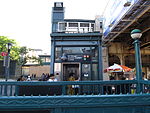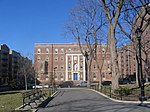Lorelei Fountain

The Lorelei Fountain, also known as the Heinrich Heine Memorial, is a monument located on East 161st Street in the Concourse section of the Bronx, New York City, near the Bronx County Courthouse. It was designed by German sculptor Ernst Herter and created in 1896 out of Italian white marble in Laas, South Tyrol. The fountain was unveiled at its current location in 1899 and is dedicated to German poet and writer Heinrich Heine. Heine had once written a poem devoted to the Lorelei, a feminine water spirit much like a mermaid that is associated with the Lorelei rock in St. Goarshausen, Germany. The monument was originally to be placed in Heine's hometown of Düsseldorf, but antisemitism and nationalist propaganda in the German Empire precluded its planned completion on Heine's 100th birthday in 1897.
Excerpt from the Wikipedia article Lorelei Fountain (License: CC BY-SA 3.0, Authors, Images).Lorelei Fountain
East 161st Street, New York The Bronx
Geographical coordinates (GPS) Address External links Nearby Places Show on map
Geographical coordinates (GPS)
| Latitude | Longitude |
|---|---|
| N 40.8275 ° | E -73.923188888889 ° |
Address
Lorelei Fountain (Heinrich Heine Memorial)
East 161st Street
10451 New York, The Bronx
New York, United States
Open on Google Maps










